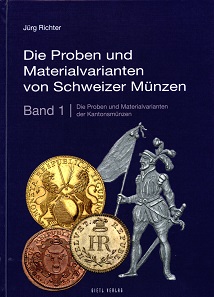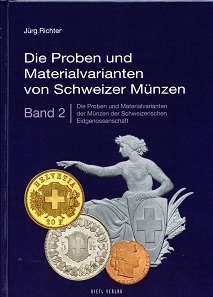by Ursula Kampmann
translated by Annika Backe
March 31, 2016 – “It’s a bit like somebody embarking on an expedition to an unexplored country for the first time: you will never discover, examine and explore everything, and the deeper you look into the subject-matter the more new and unknown things comes to light”, says Jürg Richter in his introduction to his two catalogs on the patterns and material varieties of Swiss coins.
Jürg Richter, Die Proben und Materialvarianten von Schweizer Münzen. Volume 1: Die Proben und Materialvarianten der Kantonsmünzen. Gietl Verlag, Regenstauf 2016. 335 pages with several color illustrations. 17.5 x 24.5 cm. Hardcover, thread stitching. ISBN 978-3-86646-573-4. 49.90 euros.
As a matter of fact, the varieties of Swiss coins used to be a topic that was dealt with only in footnotes but not – except for Jean-Paul Divo’s 1985 book on the official patterns of the federal coins – in a comprehensive study. It is highly useful, therefore, that the author precedes his catalog with a glossary in order to clarify terminology. After all, “pattern” is a rather arbitrary term and easily misunderstood of which advertising was (and still is) making good use in regards to private emissions.
Jürg Richter, Die Proben und Materialvarianten von Schweizer Münzen. Volume 2: Die Proben und Materialvarianten der Münzen der Schweizerischen Eidgenossenschaft. Gietl Verlag, Regenstauf 2016. 248 pages with several color illustrations. 17.5 x 24.5 cm. Hardcover, thread stitching. ISBN 978-3-86646-573-2. 49.90 euros.
Different reasons may account for a “pattern” or “material variety” being struck. A “material variety” may be due to a mint error as it occurrs when, for example, a wrong planchet was put in the minting press accidentally. Or the mint produced a “material variety” deliberately: made of metal of higher value for serving as a gift, and made of less valuable metal to test the dies. In addition, there are the official and the private “patterns” that were released for commercial purposes.
In terms of weight varieties, only a few were produced after 1850 officially whereas the majority was caused by a mis-strike which is why the author lists them only in the first volume but omits them in the second volume, referring to his 1988 book on errors and counterfeits.
Last but not least there are the fantasy coins that were produced by private parties and modelled on current issues.
Making a thorough distinction and assigning an issue that deviates from the traditional coins to the relevant category is an extraordinary piece of work in itself which required a huge amount of research.
935 numbers, most of them accompanied by color illustrations, are listed in the first volume of the catalog, covering the patterns and the varieties in metal and weight of the Swiss cantons (not to confuse with the “cantonal coins”; older patterns, reaching as far back as the 15th century, are also itemized). The heading includes the coin type, hence the denomination and the date. What it is exactly – pattern, material variety, weight variety –, is specified under the definition. The bold face printing stresses the aspects in which this variety differs from the ordinary issue. Of course, the alloy, weight and literary references are likewise given. Important is the section “Hinweis” (“note”) where Jürg Richter summarizes his findings. The prices are intended to be given in five categories but this is often omitted. It is very difficult to give a reasonable price for such rarities as R4 (2 to 4 examples known) or R5 (1 example known, may be none known in private possession). An “LP” for “Liebhaberpreis” (“collector’s price”) is much more accurate.
A more frequent site at auctions are patterns and material varieties of the Swiss Confederacy. Jürg Richter has assembled 459 numbers, of which 102 consist of patterns and material varieties of the popular shooting thalers.
To summarize: the two catalog volumes by Jürg Richter make a splendid follow-up to the HMZ catalog on Swiss coins he wrote in collaboration with Ruedi Kunzmann. The new catalog is a small gold mine – everything in the list is rare and likely to obtain a very high price. Having these two volumes in the library pays off, therefore, so you can quickly check with them if necessary and avoid any mistakes when buying and selling.
You may order the book directly at the publisher here.
Swiss readers will probably benefit from ordering the book for CHF 55 directly in Switzerland. These are the HMZ Numispost links to Volume 1 and Volume 2.





